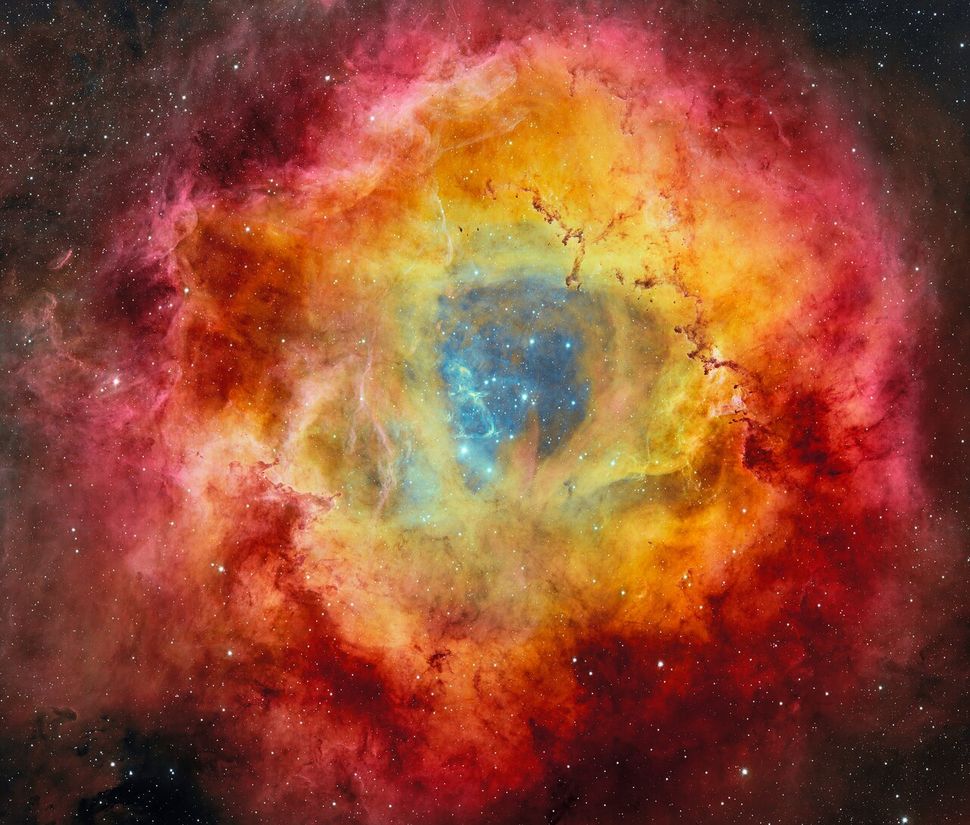The Rosette Nebula, located 5,000 light-years away, is a stunning star-forming region recently captured in detail by the Dark Energy Camera. This vibrant cosmic structure reveals the process of new star formation, offering both beauty and key insights into stellar evolution. Let’s explore why this star nursery is so significant!
What is the Rosette Nebula?
The Rosette Nebula is a sprawling emission nebula, which means that the gas within it is ionized by hot young stars at its core, causing it to glow brightly. Located about 5,000 light-years away in the constellation Monoceros, this nebula spans a massive 130 light-years in diameter. What makes the Rosette Nebula unique is that it resembles a cosmic rose, with its gas and dust swirling around a bright central cluster of young stars known as NGC 2244.

While most deep-sky objects require sophisticated telescopes to appreciate their beauty, the Rosette Nebula can be seen even through small telescopes and binoculars under the right conditions. However, its true splendor is revealed through long-exposure astrophotography, like the recent image captured by the Dark Energy Camera. The red and pink hues of ionized hydrogen gas, along with the contrasting dark regions of dense dust, create a dazzling view.
But beyond its visual appeal, the Rosette Nebula plays an essential role in the life cycle of stars.
The Star-Forming Process Inside the Nebula
The Rosette Nebula is more than just a pretty sight. It’s an active star nursery—a region where new stars are being born from clouds of gas and dust. At the heart of the nebula is the star cluster NGC 2244, made up of hot, blue, massive stars. These stars emit intense ultraviolet radiation, ionizing the surrounding gas and creating the characteristic glow of the nebula. Over time, the radiation from these stars clears out the surrounding gas and dust, forming a hollow center in the nebula.
As these massive stars energize the surrounding gas, it causes different elements within the nebula to emit light at specific wavelengths. This is why the nebula appears in such vibrant colors—hydrogen emits red light, oxygen gives off a golden-yellow glow, and ionized silicon appears pink. Each of these elements plays a role in the complex chemistry of star formation.
What’s particularly fascinating about the Rosette Nebula is that it’s home to several elephant trunks—dark, elongated structures made of dense gas and dust that are resistant to the radiation from nearby stars. These elephant trunks, which twist around magnetic field lines, are regions where new stars are forming. Inside these dense clouds, gravity pulls gas and dust together, eventually leading to the formation of new stars. Some of these nascent stars are likely to be brown dwarfs, or failed stars that never gain enough mass to ignite nuclear fusion.
Why is the Rosette Nebula Important for Science?
Astronomers study regions like the Rosette Nebula to better understand the processes of star formation and stellar evolution. Our own Sun likely formed in a nebula similar to this one about 4.6 billion years ago. By studying the Rosette Nebula, scientists gain insights into how stars, and the planetary systems that form around them, come into being.
One of the key reasons this nebula is so scientifically important is that it contains many young, massive stars that will eventually go supernova. When these stars exhaust their nuclear fuel, they explode in a violent supernova, sending shockwaves through the surrounding nebula and potentially triggering more star formation in the process. The energy from these supernovae also disperses heavy elements like carbon and oxygen—the building blocks of planets and life—into space, enriching the surrounding interstellar medium.
The fact that the Dark Energy Camera captured such a detailed image of the nebula also highlights the importance of modern technology in astronomical research. With its 500-megapixel resolution, DECam allows astronomers to study the fine details of the nebula, such as the Bok globules—compact clumps of cold dust where stars are still forming. This level of detail provides scientists with data that they can use to refine their models of star formation and the dynamics of interstellar gas clouds.
The Role of Modern Technology in Observing the Rosette Nebula
Capturing detailed images of distant cosmic objects like the Rosette Nebula requires advanced technology. The Dark Energy Camera, mounted on the Victor M. Blanco Telescope at the Cerro Tololo Inter-American Observatory in Chile, is one of the most powerful tools in astronomy today. Originally designed to study dark energy, DECam is capable of capturing long-exposure images that reveal the intricate details of nebulae, galaxies, and other deep-sky objects.
The recent image of the Rosette Nebula is a testament to the capabilities of DECam. By using filters that capture light emitted by specific elements, astronomers can create composite images that highlight the different regions of the nebula. In the case of the Rosette, the image captures the emission from hydrogen, oxygen, and silicon, revealing the complex interplay of gas and dust within the nebula.
This level of detail allows scientists to study how the radiation from the stars in NGC 2244 affects the surrounding gas and dust, and how this, in turn, influences the formation of new stars. It also provides clues about the magnetic field lines that thread through the nebula, which play a role in shaping the structure of the elephant trunks and Bok globules.
Conclusion:
The Rosette Nebula is a stunning example of the beauty and complexity of the universe. As both a visual spectacle and a region of intense scientific study, it offers us a glimpse into the processes that shape stars and galaxies. By studying nebulae like this one, astronomers can gain a deeper understanding of how stars are born, how they evolve, and how they die.



















